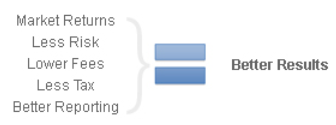The Index House follows a simple + modern approach to investing.
We build and manage properly diversified portfolios designed to maximize returns and eliminate unnecessary risk and tax.
We build and manage properly diversified portfolios designed to maximize returns and eliminate unnecessary risk and tax.

Each year investment professionals attempt to predict which will be the best stocks, which managers will outperform, or when to be in or out of the market.
These recommendations are sold to investors. The implication is that good advisors will be rewarded for thorough research and astute selections with returns greater than the market return.
Predictions however, are often wrong. Common sense tells us that in any intensely competitive industry, making consistently accurate predictions is problematic. Ask yourself, “What does my advisor know that every other advisor doesn’t?”
Thus, instead of making predictions and attempting to beat the market, the Index House structures portfolios to capture market returns by implementing the asset mix with index funds or exchange-traded funds (ETF). No crystal ball required!
Better investment results start with a strategy that is achievable. Indexing your portfolio avoids missed returns through underperformance and eliminates the guesswork required to try and identify just the winning securities.
Many investors feel stock markets today are more volatile and riskier than ever before. With this in mind, how are you safeguarding your portfolio?
Our best technique for protecting portfolios is called modern portfolio theory (MPT). Put forward by Professor Harry Markowitz in 1952, this theory says that it is insufficient to look at investments in isolation, such as the traditional approach of advisors selling investment products. Rather, you will get better returns and take less risk if you seek out combinations of securities called efficiently diversified portfolios.
Efficient portfolio diversification is achieved by combining asset classes that are not perfectly correlated or are, ideally, negatively correlated. Thus, if in the short term an asset declines in price, another rises, thereby mitigating portfolio risk.
Investors have traditionally hired brokers, mutual fund managers or portfolio managers to research and choose a relatively small number of favored securities from each asset class for the portfolio. Active portfolio management implies that astute research and selection will generate extra returns above the asset class market return.
Alternatively, investors may choose asset class securities called index funds, asset class funds or exchange-traded funds, which are designed to earn the asset class market return by owning the same or substantially all of the securities that trade in the asset class. These index funds are easily combined into efficiently diversified portfolios as per MPT. This is referred to as passive index investing.
While the theoretical underpinnings of modern portfolio theory are complex, there are two main objectives: First, efficient portfolios capture the market return of each asset class represented—nothing more and nothing less. Modern portfolio theory makes no requirement to outperform. Second, portfolios should take compensated risks and diversify away-uncompensated risk.
“Passive investing is, however, the best way to rid a portfolio of as much uncompensated risk as possible (and the only way of eliminating the risk of underperforming a given financial market.)”
Harry Markowitz
Fiduciary Focus: Active vs. Passive Investing
Morningstar, June 30, 2005
The vast majority of investors don’t know what they pay each year for the management of their portfolios. Even fewer are aware of all the costs. The Index House charges a fee for investment and financial planning advice, portfolio management, and proper reporting. This fee is agreed to up front and disclosed on a quarterly basis and at year-end.
The Index House has a process in place to minimize tax. Efficient rebalancing and trading only when necessary avoids incurring taxable gains. As well, tax-efficient portfolios are achieved by aligning investment return types among taxable and non-taxable accounts called asset location for tax efficiency.
Our reporting provides the information you require to maintain command and control over your portfolio.
The Index House Quarterly Portfolio Report provides: